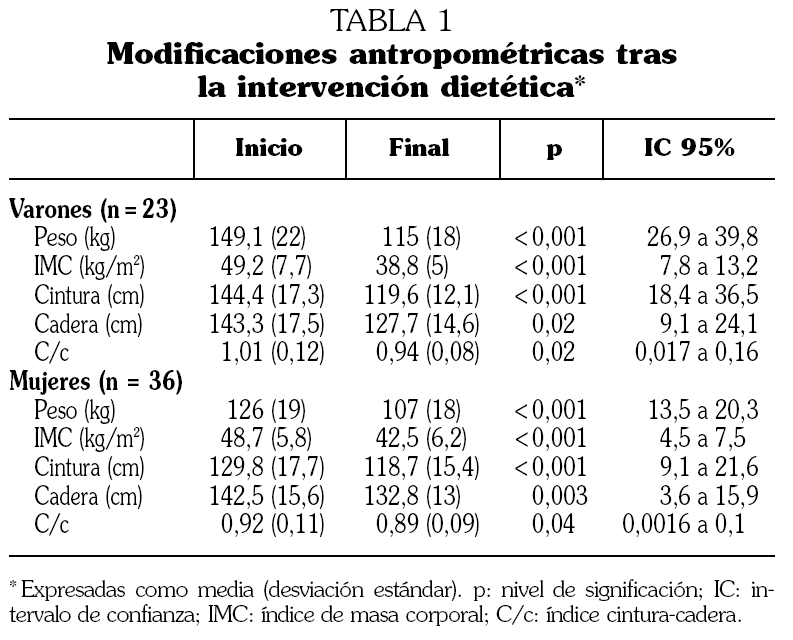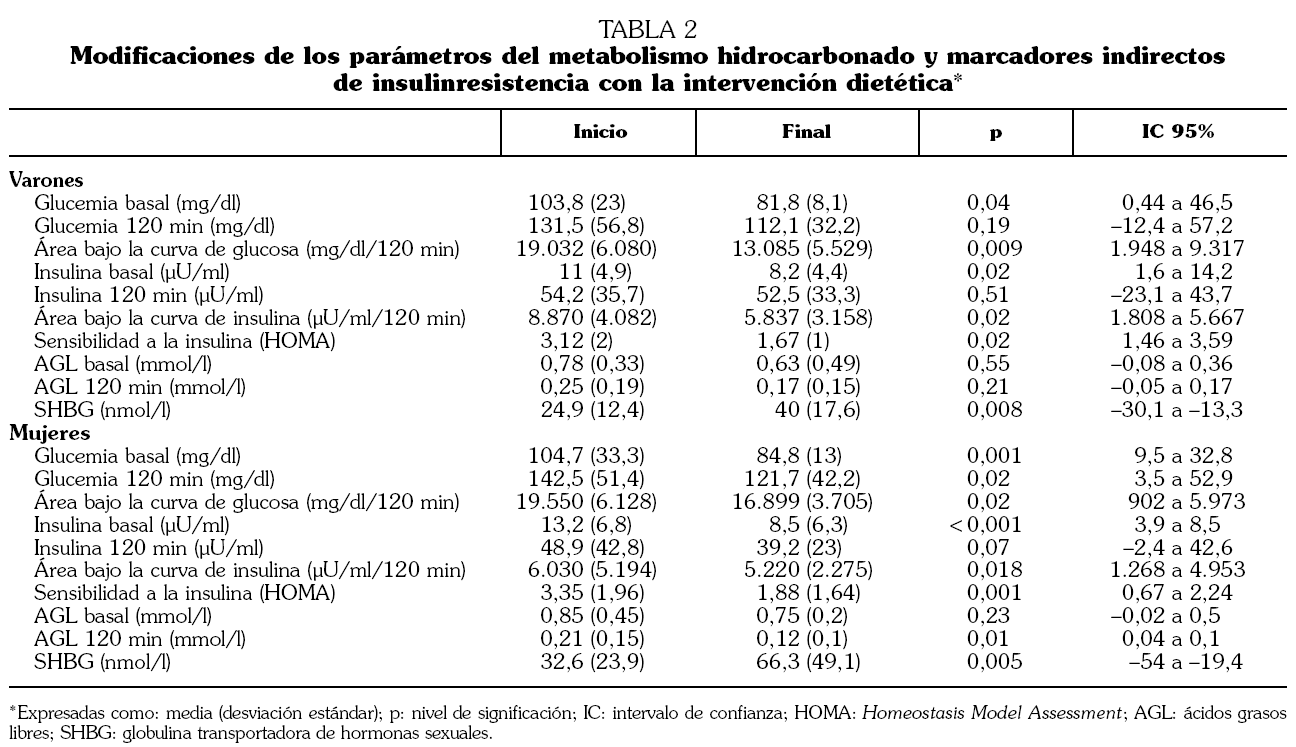Objetivo. Analizar la presencia de alteraciones del metabolismo hidrocarbonado en pacientes con obesidad mórbida y la influencia de la reducción ponderal mediante intervención dietética sobre las mismas. Valorar la influencia del sexo en la presencia de dichas alteraciones y en la respuesta a la dieta. Pacientes y métodos. A 59 pacientes con obesidad mórbida se les realizó una valoración antropométrica y del metabolismo hidrocarbonado mediante la realización de sobrecarga oral de glucosa y medición de la insulinresistencia antes y después de una intervención dietética, alternando dietas de muy bajo contenido calórico con dietas hipocalóricas convencionales. Resultados. Se apreció una reducción ponderal global muy significativa en ambos sexos (intervalo de confianza [IC] al 95%: 26,9 a 39,8 kg en varones y 13,5 a 20,3 kg en mujeres). Se encuentra una mejoría significativa en ambos sexos de la glucemia basal (IC al 95%: varones, 0,44-46,5 mg/dl; mujeres, 9,5-32,8 mg/dl) y en las mujeres de la glucemia a los 120 min de la sobrecarga oral de glucosa (IC al 95%: 3,5 a 52,9 mg/dl). Tanto los varones como las mujeres presentan mejoría significativa de la insulinemia basal (IC al 95%: varones, 1,6 a 14,2 µU/ml; mujeres, 3,9 a 8,5 µU/ml) y de la globulina transportadora de hormonas sexuales (IC al 95%: varones, 30,1 a 13,3 nmol/l; mujeres, 54 a 19,4 nmol/l). Tanto varones como mujeres mostraron una mejoría de la sensibilidad a la insulina medida por Homeostasis Model Assessment (IC al 95%: varones, 1,46 a 3,59; mujeres, 0,67 a 2,24). Conclusión. En pacientes con obesidad mórbida existe una elevada presencia de alteraciones del metabolismo hidrocarbonado. Con la reducción ponderal obtenida hemos conseguido una significativa reducción de estas alteraciones.
Palabras clave:
obesidad mórbida, dieta de muy bajo contenido calórico, alteraciones del metabolismo hidrocarbonado
Objective. Examination of carbohydrate metabolism derangements in patients with morbid obesity and the influence of weight reduction through nutritional intervention. Assessment of gender influence on carbohydrate metabolism derangements and on response to diet. Patients and method. 59 patients with morbid obesity were studied with anthropometric assessment and with carbohydrate metabolism assessment through an oral glucose overload and measurement of insulin resistance, before and after a dietary intervention alternating diets of very low caloric content with conventional low-calorie diets. Results. A very significant global weight reduction in both sexes was observed (95% confidence interval [CI], 26.9 to 39.8 kg in males, and 13.5 to 20.3 kg in women). A significant improvement in basal blood glucose was found in both sexes (95% CI: males, 0.44 to 46.5 mg/dl; women, 9.5 to 32.8 mg/dl), and in 120 minute oral glucose tolerance test (OGTT) blood glucose in women (95% CI: 3.5 to 52.9 mg/dl). Both males and women showed significant improvement in basal insulinemia (95% CI: males, 1.6 to 14.2 µU/ml; women, 3.9 to 8.5 µU/ml) and in sex hormone-binding globulins (SHBG) (95% CI: males, 30.1 to 13.3 nmol/l; women, 54 to 19.4 nmol/l). Both males and women showed an improvement of sensitivity to insulin measured with HOMA (HOMAIR) (95% CI: males, 1.46 to 3.59; women, 0.67 to 2.24). Conclusion. In patients with morbid obesity carbohydrate metabolism derangements are common. Weight reduction led to a significant reduction of these derangements.
Keywords:
morbid obesity, very low caloric content diet, carbohydrate metabolism derangements









